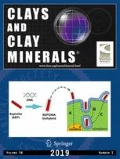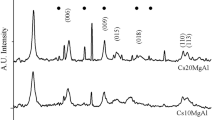Abstract
Hydrotalcite solid solutions were prepared by coprecipitation followed by hydrothermal treatment between 150° and 250°C. Based on the structural formula [Mg1−xAlx(OH)2]x+[(CO3)x/2 • mH2O]x−, pure solid solutions were formed in the range A1/(A1 + Mg) = 0.2 to 0.33, where m = (1 − 3x/2). Maximum crystallite size was achieved by hydrothermal treatment between 180° and 200°C, with x = 0.337 to 0.429. Crystal strain was also minimized at these values of x. The adsorption capacity for Naphthol Yellow S increased as x increased and reached a maximum (1.56 × 10−6 moles/m2) when x = 0.287, a value eight times larger than that of Mg(OH)2. A weak endothermic DTA peak at about 350°C is probably due to the loss of structural water in the main layer of the structure. On calcination between 400° and 700°C, only periclase was detected, probably containing Al in solid solution. Hydration of the calcined product resulted in the reconstruction of the original hydrotalcite structure.
Резюме
Твердые растворы гидроталькита приготавлялись соосаждением с последующей гидротермальной обработкой при температурах между 150° и 250°С. Чистые твердые растворы, основанные на структурной формуле [М81_хА1х(ОН)2]х+[(СO3)х/2·mН2O]x−, образовывались в диапазоне Аl/(Аl + Mg) = 0,2 до 0,33, где т = (1 − Зх/2). Максимальный размер кристаллита был достигнут гидротермальной обработкой при температуре между 180° и 200°С, с х = 0,337 до 0,429. Кристаллическая напряженность также была минимальной при этих значениях х. Адсорбционная способность для Нафтола желтого 8 увеличивалась с увеличением х и достигала максимума (1,56 х 10−6 мол/м2) при х = 0,287, что в восемь раз выше значения для Mg(ОН)2. Слабый эндотермический ДТА пик при температуре 350°С возможно обусловлен потерей структурной воды в главном слое структуры. При кальцинировании между 400° и 700°С был обнаружен только периклаз, возможно содержащий А1 в твердом растворе. Гидротация кальцинированного продукта приводит к восстановлению первоначальной гидроталькитной структуры. [N. R.]
Resümee
Hydrotalkit-Mischkristalle wurden durch Fällung und anschließende hydrothermale Behandlung bei Temperaturen zwischen 150° und 250°C erzeugt. Gemäß der Strukturformel [Mg1−xAlx(OH)2]x+[(CO3)x/2 • mH2O]x− werden reine Mischkristalle im Bereich A1/(Al + Mg) = 0,2 bis 0,33 gebildet, wobei m = (1 − 3x/2) ist. Die maximale Kristallitgröße wurde durch eine hydrothermale Behandlung zwischen 180° und 200°C erreicht mit x-Werten von 0,337 bis 0,429. Die Kristalldeformation war bei diesen x-Werten minimal. Das Adsorptionsvermögen für Naphthol Gelb S nahm mit zunehmendem x zu und erreichte bei x = 0,287 ein Maximum von 1,56 × 10−6 Mol/m2. Dieser Wert ist achtmal höher als der von Mg(OH)2. Ein schwacher endothermer DTA Peak bei ungefähr 350°C ist wahrscheinlich auf den Verlust von Kristallwasser zurückzuführen, das sich in den Hauptschichten der Struktur befindet. Bei der Kalzinierung zwischen 400° und 700°C wurde nur Periklas gefunden, der wahrscheinlich Al in fester lösung enthält. Die Hydratisierung des kalzinierten Produktes führte wieder zu der ursprünglichen Hy-drotalkitstruktur. [U. W.]
Résumé
Des solutions solides d’hydrotalcite ont été préparées par coprécipitation suivie d’un traitement hydrothermique entre 150° et 250°C. En se basant sur la formule de structure [Mg1_xAlx(OH)2]x+[(CO3)x/2 • mH2O]x−, des solutions solides pures ont été formées sur l’étendue Al/(Al + Mg) = 0,2 à 0,33, ou m = (1 −3x/2). La taille maximum de cristallite a été atteinte par traitement hydrothermique entre 180° et 200°C, avec x = 0,337 à 0,429. L’effort cristallin était aussi minimisé pour ces valeurs de x. La capacité d’adsorption pour le Naphthol Yellow S a augmenté proportionellement à la croissance de x et a atteint un maximum (1,56 × 10−6 moles/m2) quand x = 0,287, une valeur huit fois plus grande que celle de Mg(OH)2. Un faible sommet endothermique DTA à approximativement 350°C est probablement dû à la perte d’eau structurale dans la couche principale de la structure. Lors de la calcination entre 400° et 700°C, on n’a détecté que du périclase, contenant sans doute du Al en solution solide. L’hydratation du produit calciné a donné lieu à la reconstruction de la structure d’hydrotalcite d’origine. [D. J.]
Similar content being viewed by others
References
Allmann, R. (1968) The crystal structure of pyroaurite: Acta Crystallogr. 24, 972–977.
Beck, C. W. (1950) Differential thermal analysis curves of carbonate minerals: Amer. Mineral. 35, 1006–1007.
Feitknecht, W. (1942) Über die Bildung von Doppelhydroxyden Zwischen zwei- und dreiwertigen Metallen: Helv. Chim. Acta 25, 555–560.
Frondel, C. (1941) Constitution and polymorphism of the pyroaurite and sjögrenite groups: Amer. Mineral. 26, 295–306.
Gastuche, M. C, Brown, B., and Mortland, M. M. (1967) Mixed magnesium-aluminium hydroxides: Clay Miner. 7, 177–201.
JCPDS (1967) X-ray powder data file: card number 4-0829, A.S.T.M., Philadelphia, U.S.A.
Jones, F. W. (1938) The measurement of particle size by the X-ray method: Proc. Roy. Soc. London A 166, 16–42.
Kobo, B., Miyata, S., Kumura, T., and Shimada, M. (1967) Physical and chemical characteristics and antacid activities of synthetic hydrotalcite: Yakuzaigaku 29, 215–219.
Miyata, S., Kumura, T., Hattori, H., and Tanabe, K. (1971) Physico-chemical properties and structure of magnesia-alumina: Nippon Kagaku Zasshi 92, 514–519.
Miyata, S. (1975) The syntheses of hydrotalcite-like compounds and their structures and physico-chemical properties: Clays & Clay Minerals 23, 369–375.
Roy, D. M., Roy, R., and Osborn, E. F. (1953) The system MgO-Al2O3-H2O and influence of carbonate and nitrate ions on the phase equilibria: Amer. J. Sci. 251, 337–360.
Taylor, H. F. W. (1973) Crystal structures of some double hydroxide minerals: Mineral. Mag. 39, 377–388.
Ueno, K. (1961) Chelate titration method: Nankodo, Japan, pp. 205, 274.
Williamson, G. K. and Hall, W. H. (1953) X-ray line broadening from filed aluminum and wolfram: Acta Met. 1, 22–31.
Author information
Authors and Affiliations
Rights and permissions
About this article
Cite this article
Miyata, S. Physico-Chemical Properties of Synthetic Hydrotalcites in Relation to Composition. Clays Clay Miner. 28, 50–56 (1980). https://doi.org/10.1346/CCMN.1980.0280107
Received:
Accepted:
Published:
Issue Date:
DOI: https://doi.org/10.1346/CCMN.1980.0280107




